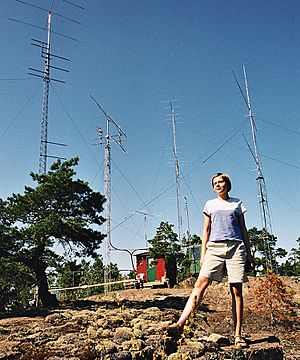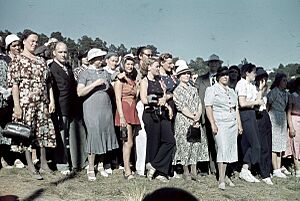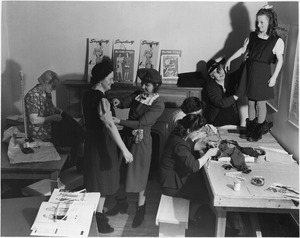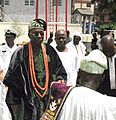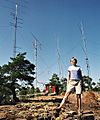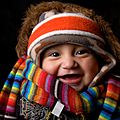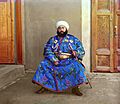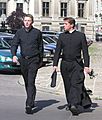Clothing facts for kids
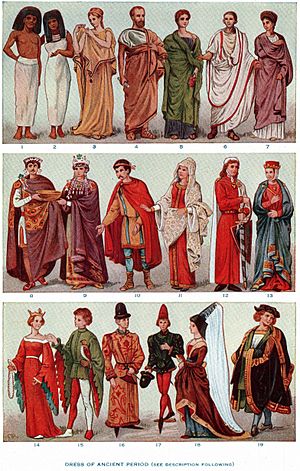
Clothing (also known as clothes or garments) is anything we wear on our bodies. Most clothes are made from fabrics like cotton or wool. But throughout history, people have also used animal skins and other natural materials. Wearing clothes is a unique human trait, found in all societies.
Clothes serve many important purposes. They protect us from the weather, like cold, heat, rain, and sun. They also shield our skin from rough surfaces, sharp objects, or insect bites. Clothes can keep us clean by creating a barrier against dirt and germs. Footwear protects our feet, gloves cover our hands, and hats protect our heads. Clothes also help us carry things with pockets or belts.
Beyond protection, clothing has a big social role. What we wear can show our social status, wealth, or even what group we belong to. It can also express our individual style. In many places, there are social rules about covering certain parts of the body. Not wearing clothes in public in a way that shows private areas can be seen as inappropriate.
Contents
Clothing: What We Wear
How Clothing Began
Scientists believe humans started wearing clothes a very long time ago, possibly over 100,000 years ago. One way they estimate this is by studying lice. Body lice can only live in clothing. This suggests that when body lice first appeared, humans were already wearing clothes.
Archaeological finds also support these ideas. In September 2021, scientists found evidence in Morocco that clothes were being made 120,000 years ago. Early clothes were likely made from animal skins, leaves, or grass. These materials don't last long, so direct evidence is rare.
Early Materials and Tools
Archaeologists have found very old sewing needles made of bone and ivory. Some are from about 30,000 BC in Russia. A needle found in Siberia was even older, around 50,000 years old. Dyed flax fibers, possibly used for clothing, were found in Georgia and date back to 34,000 BC.
The oldest known woven garment is the Tarkhan dress. This linen dress is over 5,000 years old!
How Clothes Are Made
Many different cultures have created unique ways to make clothes. Some groups, especially in cold places, made clothes mainly from animal furs and skins. Other societies used fibers from animals like wool, or plants like linen, cotton, and silk. They would weave or knit these fibers into textiles.
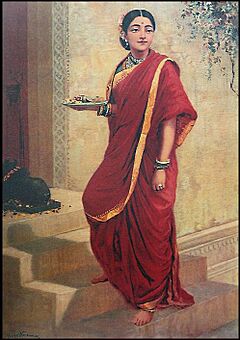
From Handcraft to Machines
Making fabric by hand used to be a very long and hard process. It involved many steps like preparing fibers, spinning them into thread, and then weaving. The Industrial Revolution brought machines like the power loom. This made making textiles much faster and easier.
Some clothes are made by simply wrapping or draping a piece of cloth around the body. Examples include the sari in India or the Scottish kilt. These garments often don't need to be cut or sewn. They can be held in place with ties, pins, or belts. This means people of different sizes can wear the same garment.
Another way is to measure, cut, and sew fabric. This can be done by hand or with a sewing machine. Tailors use sewing patterns and adjust them to fit a person perfectly. In the past, people tried to use every bit of expensive fabric. Today, modern fashion often cuts fabric in ways that leave leftover pieces. These scraps can be used for quilts or other crafts.
Over thousands of years, humans have created an amazing variety of clothing styles. We learn about these styles from old clothes, photos, paintings, and written descriptions. This history inspires today's fashion designers and costume makers for movies and plays.
Why Clothes Feel Good
Clothes do more than just cover us; they also make us feel comfortable. Comfort comes from how clothes look, feel, and help our bodies.
Different Kinds of Comfort
- How it looks: This is called aesthetic comfort. It's about how the color, style, and fit of clothes make us feel good when we look at them.
- Staying warm or cool: This is thermal comfort. Good clothing helps our bodies keep a steady temperature. It keeps us from getting too hot or too cold. Natural fibers like cotton breathe well and absorb moisture. Synthetic fibers like polyester can repel moisture. Choosing the right material for the weather is important.
- Feeling dry: Moisture comfort means preventing a damp feeling. Clothes that wick away sweat help us stay dry and comfortable.
- How it feels to touch: Tactile comfort is about the feel of the fabric against our skin. Soft, smooth fabrics feel nice, while rough or scratchy ones can be uncomfortable. Special finishes can make fabrics feel even softer.
- How it presses on you: Pressure comfort relates to how clothes fit. Fabric with lycra feels more comfortable because it moves with your body without being too tight or too loose.
Clothes and Culture
Clothes have always been a way to show who we are and where we belong. They reflect our society's rules and values.
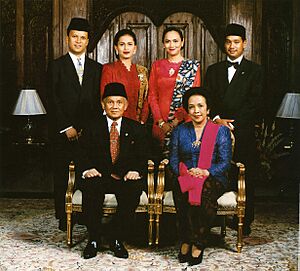
Clothes for Different Genders
In most cultures, there are differences in clothing styles for boys and girls, or men and women. These differences can be in styles, colors, or fabrics. For example, in Western societies, skirts and dresses are usually worn by women. Trousers were once only for men, but now both genders wear them.
Sometimes, men wear traditional garments like togas or kilts for special events. In some cultures, like in Islam, women are expected to cover more of their bodies. This can range from a headscarf to a burqa.
Showing Your Status
Throughout history, clothes have shown a person's rank or status. In ancient Rome, for example, only senators could wear garments dyed with Tyrian purple. In traditional Hawaiian society, only high-ranking chiefs wore feather cloaks.
Today, in many societies, expensive or designer clothes can signal wealth or status. What our friends wear can also influence our clothing choices.
Clothes and Beliefs
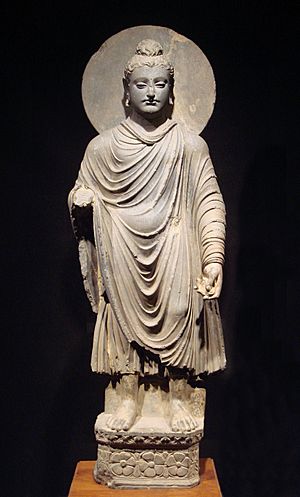
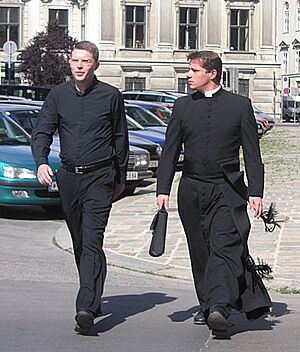
Some religions have special clothing. This might be worn only during ceremonies or every day to show religious identity. For example, Sikhs wear a turban as part of their faith.
Cleanliness of religious clothes is very important in religions like Hinduism and Buddhism, symbolizing purity. The Bible and Quran also mention clothing in many stories and teachings. Christian priests wear special vestments during church services.
Clothes Today
The way people dress has changed a lot over the last 500 years. Machines made clothes more affordable and available. Styles kept changing, and new synthetic fabrics also influenced what was considered fashionable.
Global Styles
By the early 2000s, Western clothing styles became popular worldwide. This started centuries ago during European colonialism. Today, media and global companies continue to spread these styles. Fast fashion makes trendy, inexpensive clothes available everywhere. Also, used clothes from wealthier countries are often sent to people in poorer countries by charities.
Special Clothes for Sports
Most sports and physical activities require special clothing for comfort, safety, or practical reasons. Common sportswear includes shorts, T-shirts, and trainers. Specialized gear includes wet suits for swimming or diving, and leotards for gymnastics. Stretchy materials like spandex are often used for active sports because they fit well and soak up sweat.
The World of Fashion
From 1900 to 1940, Paris was a major trendsetter for fashion in Europe and North America. Today, fashion has many different styles. These styles vary by location, media influence, and economic conditions. Fashion can range from expensive designer clothes to traditional outfits. Fashion shows are events where designers show off their new and often exciting designs.
Important Issues About Clothing
Making Clothes Fairly
Even though machines changed how clothes are made, many garment workers still do repetitive manual labor. Often, mass-produced clothes are made in challenging conditions. These can include long work hours and a lack of benefits or worker representation. This happens in both developing and industrialized nations.
Groups like the Clean Clothes Campaign work to improve these conditions. They raise awareness about the importance of fair treatment for workers.
Choices About Materials
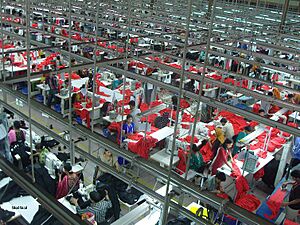
Using animal fur in clothing dates back to ancient times. Today, some indigenous people still use fur for warmth. However, in many developed countries, fur is seen as a luxury item. Many people and organizations believe that using animal fur is cruel and unnecessary.
Because of these concerns, some fashion events and designers have stopped using real fur. For example, Copenhagen and London fashion weeks banned real fur from their shows. Brands like Gucci, Chanel, and Versace also stopped using fur in their collections. In 2021, Israel became the first country to ban the sale of new real fur garments, with some exceptions for religious use.
Taking Care of Your Clothes
Clothes can get dirty from our bodies or from the environment. Sun, moisture, and dirt can also damage them. If clothes are not cleaned and cared for, they can wear out and lose their look and usefulness.
Cleaning and Storing Clothes

Humans have developed many ways to clean clothes. These range from washing them in streams to using modern washing machines and dry cleaning. Hot water washing and ironing are traditional ways to keep clothes clean and hygienic.
Many clothes need to be ironed to remove wrinkles and look neat. However, much casual clothing today is made from materials that don't wrinkle easily. Some clothes are also "permanent press," meaning they are treated to resist wrinkles.
After cleaning, clothes are usually hung on clothes hangers or folded. This keeps them fresh and prevents creases. To protect clothes from pests like moths, they can be stored in cedar closets or with mothballs.
Fixing and Reusing Clothes
In the past, when fabric was expensive, people spent a lot of time mending clothes. A skilled tailor could fix tears so well they were almost invisible. Today, mass-produced clothes are often cheaper than the cost of repairing them. Many people buy new clothes instead of mending old ones. However, some people still replace zippers, sew on buttons, or fix ripped hems. Other ways to fix clothes include darning or upcycling them with visible mending.
Recycling Old Clothes
It's estimated that 80 billion to 150 billion garments are made each year. Used clothes that can't be worn anymore can be turned into quilts, rags, rugs, or bandages. In Western countries, used clothing is often thrown away or donated to charity. It's also sold to consignment shops or online. Globally, used clothes are a big business, often shipped to poorer countries for reuse.
Synthetic fabrics, made from oil, are not renewable or biodegradable. Sometimes, extra new clothing is destroyed by companies to keep their brand value high.
Clothes Around the World
The global trade of clothing is huge. In 2022, the value of clothing exports worldwide reached US$790.1 billion. China is the largest exporter, followed by Bangladesh, Vietnam, India, and Turkey. These countries play a big role in making clothes for people all over the world. For example, Vietnam's clothing exports reached US$39.8 billion in 2022, with a large portion going to the United States and the EU.
Images for kids
-
Paris 1860
-
The Oba (Nigeria)
-
Clothing in history, showing (from top) Egyptians, Ancient Greeks, Romans; Byzantines, Franks; and thirteenth through fifteenth century Europeans
-
A kanga, worn throughout the African Great Lakes region
-
Hindu lady wearing a sari, one of the most ancient and popular pieces of clothing in the Indian subcontinent, painting by Raja Ravi Varma
-
A woman wearing a sports bra and boyshorts, often worn as casuals or athleisure
-
Fashion shows often show the latest trends in clothing fashions, a model in a modern gown at an Haute couture fashion show
-
Laundromat in Walden, New York, United States
-
Japanese PM Shinzō Abe and Ivanka Trump (right) wearing Western-style business suits (2017)
-
Italian actors Gabriel Garko in a suit and Laura Torrisi in a gown, considered Red carpet fashion (2009)
-
3rd Duke of Fife wearing a traditional Scottish kilt (1984)
-
Achkan sherwani and churidar worn by Arvind Singh Mewar and his family during a Hindu wedding in Rajasthan, India
-
The Buddha wearing kāṣāya robes, worn by fully ordained Buddhist monks and nuns
-
Clerical clothing worn by Catholic priests
See also
 In Spanish: Ropa para niños
In Spanish: Ropa para niños
- Children's clothing
- Clothing laws by country
- Cotton recycling
- Global trade of secondhand clothing
- Higg Index
- List of individual dresses
- Organic cotton
- Reconstructed clothing
- Right to clothing
- Sustainable fashion
- Textile recycling
- Vintage clothing
- Zero-waste fashion


